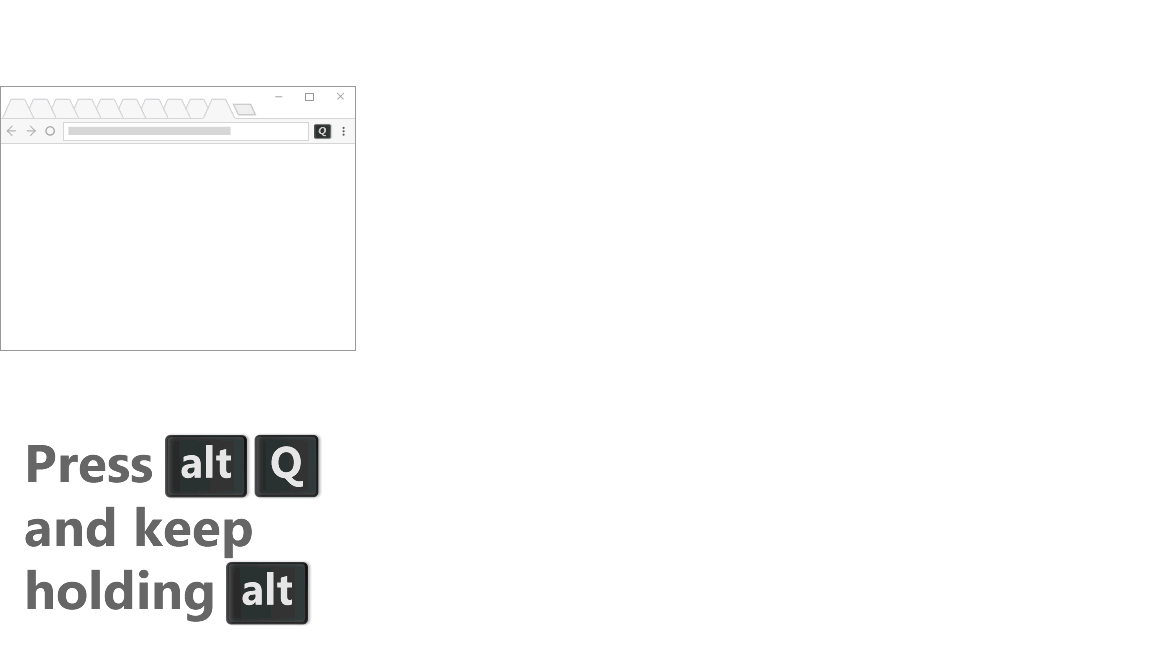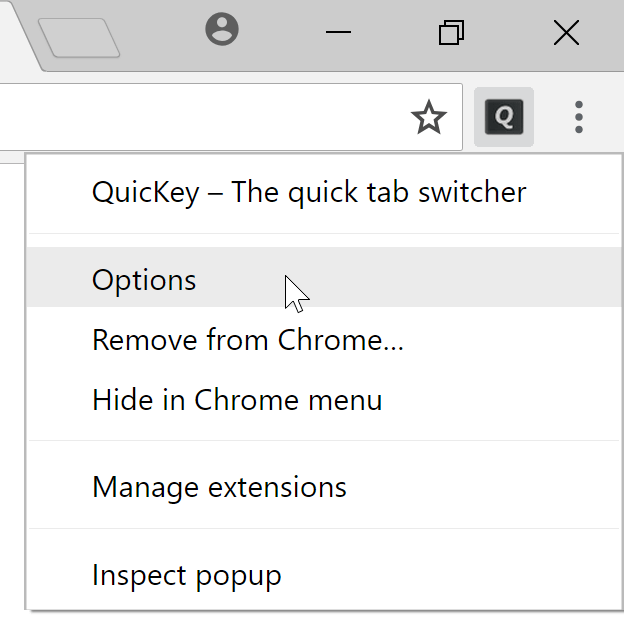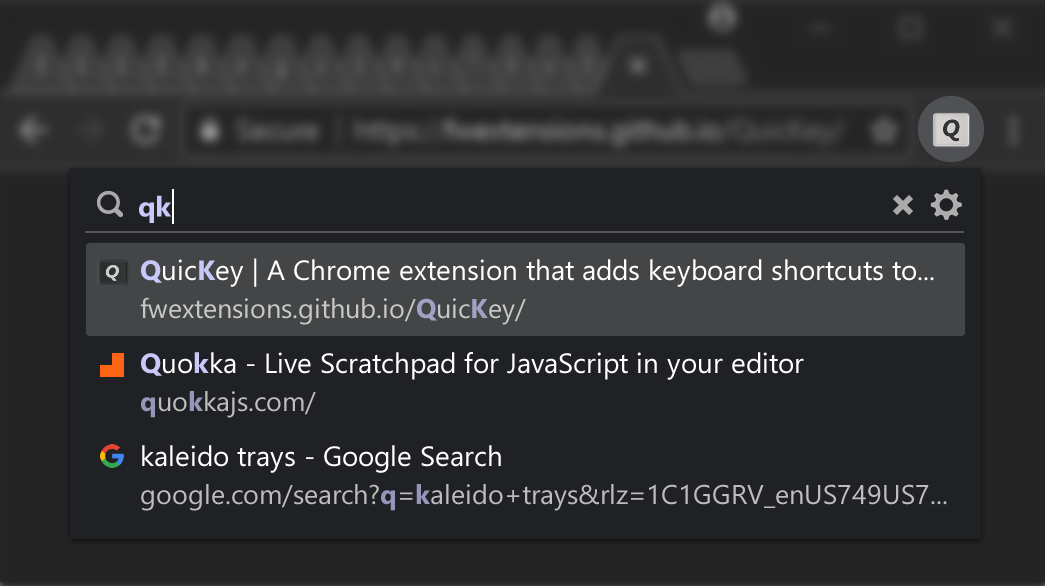QuicKey lets you navigate all of your Chrome tabs by typing just part of a page's title or URL. No mouse needed!
- Press altQ (ctrlQ on macOS).
- Type a few letters.
- Press enter to switch to the selected tab.
To toggle between the two most recently used tabs, quickly press the keyboard shortcut twice. Or pick a tab from the most recently used (MRU) list as shown below.
With a little extra work, you can even make QuicKey respond to the Holy Grail of keyboard shortcuts: ctrltab. Learn how.
Install QuicKey from the Chrome Web Store.
Once the extension is installed, you can click the ![]() button on the toolbar to open the search box. But if you like this extension, you'll probably prefer using the default keyboard shortcut listed above.
button on the toolbar to open the search box. But if you like this extension, you'll probably prefer using the default keyboard shortcut listed above.
You can customize the shortcut key by right-clicking the QuicKey icon and selecting Options. Or manually add a ctrltab keyboard shortcut.
Note: When first installed, QuicKey doesn't know which tabs have been recently used, but as you use Chrome, tabs will get added to the most recently used (MRU) list.
Opening QuicKey displays a list of the last 50 tabs you've visited, in order of recency. Click a tab to switch to it, or use one of the keyboard shortcuts below to navigate the recently used tab history:
- To switch between the two most recent tabs:
- Press altZ (ctrlZ on macOS).
- OR
- Quickly double-press altQ (ctrlQ on macOS).
- Press altZ (ctrlZ on macOS).
- To navigate farther back in the MRU list:
- Press altA (ctrlA on macOS) once to switch to the previous tab. The QuicKey icon will invert for .75 seconds:
 ➤
➤  .
. - Press altA again while the icon is inverted to switch to older tabs, once for each tab.
- Press altS to move to newer tabs.
- Pause to let the icon revert to normal:
 ➤
➤  .
. - Press altA again to switch back to the tab you initially started on.
- Press altA (ctrlA on macOS) once to switch to the previous tab. The QuicKey icon will invert for .75 seconds:
- To pick a recent tab from the MRU menu:
- Press the shortcut but keep holding the alt key (ctrl key on macOS).
- Press W or ↓ to move down through the list of recent tabs.
- Press shiftW or ↑ to move up.
- Release alt (or ctrl) to switch to the selected tab.
- You can also highlight an item with the mouse, then release alt to go to that tab.
Which shortcuts to use is up to you. Double-pressing altQ is nice because there's just one shortcut to remember, while altZ lets you switch between the two most recently used tabs very rapidly. (You can also double-click the QuicKey icon to toggle between the most recent tabs.)
altA lets you navigate to even older tabs, though the timing can sometimes be finicky.
Selecting from the MRU menu by holding down the alt key provides the closest experience to a typical alttab menu, but you need to use W instead of tab to navigate while the menu is open (due to limitations in the Chrome platform).
You can change any of these shortcuts by clicking the icon in the menu or by right-clicking the QuicKey icon and selecting Options. Then scroll down and click Change browser shortcuts. Look for the Switch to the previous/next tab shortcuts.
If you enable the option to show the number of open tabs on the QuicKey icon, the badge containing that number will change color while you navigate to older tabs, rather than the icon inverting.
Unlike other tab switchers, QuicKey uses a Quicksilver-style search algorithm to rank the results, where contiguous matches at the beginning of words are higher in the list, as are matches against capital letters. So you only have to type a few letters to quickly find the right tab.
Use keyboard shortcuts to navigate the list of matching tabs:
- enter : switch to the selected tab
- ↓, space, ctrlN or ctrlJ : move down the list
- ↑, shiftspace, ctrlP or ctrlK : move up the list
- pg dn : page down the list
- pg up : page up the list
- end : go to the bottom of the list
- home : go to the top of the list
- esc : clear the search or close the menu
If you type more than 25 letters, which should be plenty to find the right tab, QuicKey switches to an exact string search to stay fast.
Recently used tabs get a slight boost in the search results ranking, so getting back to a tab you were just using should require typing fewer letters.
To customize how QuicKey behaves, click the icon in the menu, or right-click its toolbar icon
![]() and select Options from the menu:
and select Options from the menu:
On the QuicKey options page, you can change the behavior of the space and esc keys, mark tabs in other windows with an icon, hide closed tabs from the search results, show the number of open tabs, and customize many of the keyboard shortcuts described here.
If you change the keyboard shortcut for showing the QuicKey menu to something other than the default altQ or if you have a non-US keyboard, you'll probably want to also change the key that's used to navigate down the list of recently used tabs (which defaults to W). For instance, if you change the menu shortcut to altZ, you might want to change the navigation key to X, which is right next door. To change it, go to the Options page, click in the first keyboard shortcut picker, and press X.
If new settings have been added to QuicKey since the last time you looked at the options page, the icon will display a red dot to let you know.
To close the selected tab, press ctrlW (cmdctrlW on macOS, ctrlaltW on Linux). Or hover over a tab and click the close button on the right side of the menu:
When you open QuicKey, the 25 most recently closed tabs are listed below the recent tabs and shown in a faded state with a icon:
They are also returned when you type a query, though their rank in the list of results is lower than open tabs. Click a closed tab to reopen it in its original location and with all of its browsing history intact.
If you don't want any closed tabs to be shown, open the QuicKey options page and uncheck Include recently closed tabs in the search results. You can also remove the selected closed tab from the browser's history by pressing ctrlW (cmdctrlW on macOS) or by clicking its button on the right side of the menu.
You can move tabs to the left or right of the current tab, making it easy to pull tabs from other windows into the current one, or to rearrange tabs without using the mouse.
- Press ctrl[ to move the selected tab to the left of the current one.
- Press ctrl] to move it to the right.
The ctrl key should be used on both Windows and macOS. Note that you cannot move tabs between normal and incognito windows.
A tab that has the same title as other open tabs will display a number to indicate its left-to-right position among those other tabs. For instance, if you open tabs for two different Google Drive accounts, they'll both be titled My Drive - Google Drive. But the one on the left will show a 1 next to its title in the menu and the one on the right will show a 2. This makes it easier for you to select the tab you want when you know how they're organized in your window.
To find a bookmark, type /bspace in the search box, and then part of the bookmark's name or URL.
- Press enter to open the bookmark in the current tab.
- Press ctrlenter (cmdenter on macOS) to open it in a new tab in the current window.
- Press shiftenter to open it in a new window.
As soon as you type /bspace, your bookmarks will be listed in alphabetical order, in case you want to browse through them. Since bookmarks can be organized into folders, the folder path is shown before each bookmark's title. The folder path can be hidden by unchecking Show the folder path to each bookmark in its title on the Options page.
To find something in the last 2000 pages of your browser history, type /hspace in the search box, and then part of the page's name or URL.
The same ctrlenter (cmdenter on macOS) and shiftenter shortcuts will open the visited page in a new tab or window.
As soon as you type /hspace, the pages from your history will be listed in order of recency, so you can get back to a page you had recently visited without having to remember its name.
To delete the selected bookmark or history item, press ctrlW (cmdctrlW on macOS). Or hover over an item and click the button on the right side of the menu. You'll be asked to confirm the deletion of bookmarks.
To switch to incognito tabs as well as normal ones, click the icon in the menu, or right-click the QuicKey icon
![]() and select Options from the menu:
and select Options from the menu:
Scroll to the very bottom of the QuicKey options page and then click the Change incognito settings button. On the extensions page that opens, scroll down to the Allow in incognito option and click the toggle button:
Tabs in incognito mode display the incognito icon under the page's favicon, so you can distinguish a normal tab from an incognito one with the same title:
QuicKey will respond to changes in your computer's dark mode setting with darker colors that match your browser's user interface.
You can also copy the URL and title of the selected tab, bookmark or history item:
- Press ctrlC (cmdC on macOS) to copy just the URL.
- Press ctrlshiftC (cmdshiftC on macOS) to copy both the item's title and its URL, one per line.
When first installed, QuicKey asks for these permissions:
-
Read and change your browsing history on all signed-in devices
QuicKey uses this permission to let you search the titles and URLs of the open tabs, as well as pages from your history. The "all signed-in devices" part is there only so that recently closed tabs can be restored with their full history. The only time QuicKey changes your browsing history is when you choose to delete a history item.
-
Read and change your bookmarks
QuicKey uses this permission to let you search the titles and URLs of your bookmarked pages. The only time it changes your bookmarks is when you choose to delete one.
QuicKey can't access or manipulate the content of any pages you visit and doesn't transmit any information other than some anonymized diagnostic data.
If you right-click the QuicKey icon on the toolbar, there's a message saying Can't read or change site's data, which is a bit misleading, since it can't read or change any site's data, not just the current one.
If you find a bug in QuicKey or have a suggestion for a new feature, please create a new issue on its GitHub page.
View the changes in previous releases.
The ,
,
,
and
icons are from the Octicons set, used under the MIT License. The
icon is from the Material Icons set, used under the Apache License.
The string ranking algorithm is modeled on Quicksilver's code.











